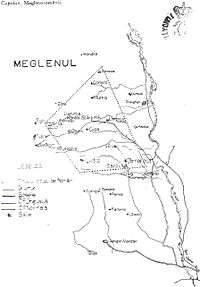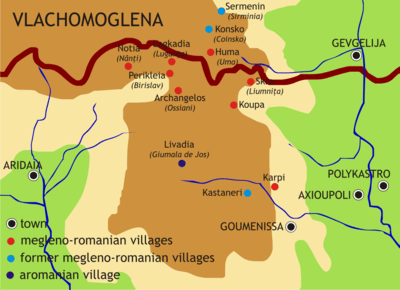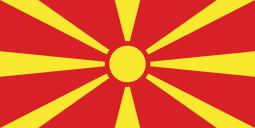Megleno-Romanians
The Megleno-Romanians (Romanian: Meglenoromâni), Moglenite Vlachs (Greek: Βλαχομογλενίτες, Vlachomoglenítes) or simply Meglenites (Romanian: Megleniţi, Megleno-Romanian: Miglinits) or Vlachs (Megleno-Romanian: Vlaș ; Romanian: Vlaşi. Macedonian: Власи) are a small Eastern Romance people, originally inhabiting seven villages in the Moglena region spanning the Pella and Kilkis regional units of Central Macedonia, Greece, and one village, Huma, across the border in North Macedonia. These people live in an area of approximately 300 km2 in size. Unlike the Aromanian Vlachs, the other Romance speaking population in the same historic region, the Meglen Vlachs are traditionally sedentary agriculturalists, and not traditionally transhumants.
| Total population | |
|---|---|
| 5,000–20,000 | |
| Regions with significant populations | |
| 4,000 | |
| 1,000 | |
| 4,000–5,000[1] | |
| 1,200 | |
| Languages | |
| Megleno-Romanian, Greek, Macedonian | |
| Religion | |
| Orthodox Christianity, Sunni Islam (in Turkey) | |
| Related ethnic groups | |
| Aromanians, Daco-Romanians, Istro-Romanians | |
They speak a Romance language most often called by linguists Megleno-Romanian or Meglenitic in English, and βλαχομογλενίτικα (vlachomoglenítika) or simply μογλενίτικα (moglenítika) in Greek. The people themselves call their language vlahește, but the Megleno-Romanian diaspora in Romania also uses the term meglenoromână.
Unlike the other Balkan Romance populations, over time Megleno-Romanians have laid aside a name for themselves which originates in the Latin Romanus, and instead have adopted the term Vlasi or Vlashi, derived from "Vlachs", a general term by which, in the Middle Ages, non-Romance peoples designated Romance peoples and shepherds. The term Megleno-Romanians was given to them in the 19th century by the scholars who studied their language and customs, based on the region in which they live.
Their number is estimated between 5,213 (P. Atanasov, most recent estimate), and 20,000 (P. Papahagi, c. 1900). There is a larger Megleno-Romanian diaspora in Romania (c. 1,500 people), and a smaller one in Turkey (c. 500 people). Greece does not recognize national minorities, thus this approximately 4,000-strong community does not have any official recognition from Greece. Another 1,000 Megleno-Romanians live in North Macedonia. It is believed, however, that there are up to 20,000 people of Megleno-Romanian descent worldwide (including those assimilated into the basic populations of these countries).
Origins
The Moglena region (Turkish: Karacaova) is located in the north of Greece at the border with North Macedonia. It is roughly bounded by the Vardar river to the east, by the Kožuf and Voras mountains to the west, by the plains of Giannitsa and Edessa to the south, and by the Mariansca Mountains to the north.[2]
Historians Ovid Densusianu and Konstantin Jirecek considered that Megleno-Romanians descended from a mixture of Romanians with Pecenegs, settled in Moglen by the Byzantine Emperor Alexios I Komnenos in 1091. They argued this on the basis in part of the Asian-like facial appearance (more prominent cheek bones) of Meglen Vlachs. By contrast, Gustav Weigand and George Murnu believed that Megleno-Romanians were descendants of the Romanian-Bulgarian Empire who retreated to Moglen.[3] This view was opposed by Jiricek. Pericle Papahagi argued another version, that Megleno-Romanians are descendants of a group of Romanians who were incorrectly called Vlachs.[4]
Megleno-Romanians used to have a traditional custom, called bondic, where the head of a household would take an oak log and place it in the hearth just before Christmas, burning it bit by bit until Epiphany. The resulting charcoal would be put under fruit trees to make them fertile. A similar custom called bavnic, but with specific variations, also existed among Aromanians, some Romanians and Latvians.[5] This custom is found in Orthodox South Slavic cultures (Serbian badnjak, Bulgarian budnik, Macedonian badnik). Some believe that these customs and other cultural archetypes discovered by scientists are proof that Megleno-Romanians come from a traditional mountainous region.[6]
Theodor Capidan, studying the resemblance of the Megleno-Romanian language with Romanian and other languages, concluded that Megleno-Romanians must have spent some time in the Rhodope Mountains before moving on to Moglen (due to the presence of elements similar to those found in the language of the Bulgarians in the Rhodopes).[7] Both Papahagi and Capidan observed that Aromanian and Megleno-Romanian lack a Slavic influence, but show Greek influence instead. The study of Megleno-Romanian and other Balkan Romance varieties led Capidan to believe that during the establishment of the Romanian language in the Early Middle Ages, there was an ethnic Romanian continuity on both banks of the Danube (north and south).
From the medieval and modern periods, it is known that Megleno-Romanians had an administration of their own. Each village was led by a captain. Their economic and social centre was the town of Nânta. After the incursions of the Pomaks of Moglen against the Ottomans, the latter started a persecution campaign against villages in the area, including those of the Megleno-Romanians. Most of the villages were put under the administration of an Ottoman bei, who exploited them to the extreme in exchange for their security. The village of Osani, however, resisted much longer before being subdued by the Ottomans, because its captain was more skilled militarily.
Demographic history
The number of Megleno-Romanians was estimated by different authors as follows:
In 1900, the then province of Gevgelija, which contained most of the Megleno-Romanian settlements, had a population of 49,315, of which 20,643 Slavs, 14,900 Turks, 9,400 Christian Aromanians and Megleno-Romanians, 3,500 Muslim Megleno-Romanians, 655 Gypsies, and 187 Circassians. The villages of Meglen Vlachs had in 1900 the following populations:

| Village | Population |
| Notia (Nânti, Nânta) | 3,660 |
| Perikleia (Birislav) | 380 |
| Lagkadia (Lugunţa) | 700 |
| Archangelos (Ossiani, Osani) | 1,500 |
| Skra (Liumniţa) | 2,600 |
| Koupa (Cupa) | 600 |
| Kastaneri (Baroviţa) | 237 |
| Karpi (Tarnareca) | 400 |
| Huma (Uma) | 490 |
| Konsko (Coinsco) | 560 |
| Sermenin (Sirminia) | 480 |
| Livadia (Giumala de Jos)1 | 2,100 |
1Aromanian village surround by the Megleno-Romanian ones.
20th century
Most Meglen Vlachs are Orthodox Christians, but the population of the village of Nânti (Nótia), which in 1900 had a population of 3,660, of which 3,500 Megleno-Romanians, in the Upper Karadjova Plain converted to Islam in the 17th or 18th century. It is the only case among Eastern Romance populations of an entire community converting to Islam.[13] The entire population of this village was expelled by force to Turkey in 1923, as part of the population exchange between Greece and Turkey, where they mostly settled in Kırklareli and Şarköy, and became known as Karadjovalides[14] after the Turkish name of Moglen.[15]
Since 1913, after the Second Balkan War, there was a general policy of the Balkan states to achieve greater ethnic uniformity through exchange of population. On September 29, 1913, a first such treaty was signed between Turkey and Bulgaria regarding exchange of population up to a range of 15 km from their border. The Treaty of Neuilly-sur-Seine (November 27, 1919) led to an exchange of 40,000 Greeks for 80,000 Bulgarians between the two countries. After the Greek-Turkish War, by the Treaty of Lausanne, 500,000 of Turks and other Muslims were exchanged for a comparable number of Asia Minor Greeks. Muslim Megleno-Romanians, despite all their protests were forcefully deported to Turkey because of their religion. A significant number of incoming Greeks were settled in Greek Macedonia and Greek Thrace, including in traditional Aromanian and Megleno-Romanian areas. Economic and social consequences soon ensued, and local conflict between Aromanians and Greeks appeared. Acts of intimidation by the Greek authorities led to the formation in 1921–1923 of a national movement among Aromanians and Megleno-Romanians favourable to the idea of emigration to Romania, especially from Moglena, Veria and Vodena.[16][17]
In 1926, about 450 families of Megleno-Romanians of Greece moved to Romania, and settled in Southern Dobruja (Cadrilater or 'Quadrilateral'), a region which became Romanian in 1913. They originated from the villages of Osani, Liumnita, Cupa, Lundzini, Birislav, Livezi, and were settled in villages around the city of Durostor such as Cocina (Turkish: "Koçina", now Profesor-Ishirkovo), Cazimir (Turkish: "Kazemir", now Kazimir), Capaclia (Turkish: "Kapaklı", now Slatina), Bazarghian (Turkish: "Bezirgan", now Miletich), Aidodu (Turkish: "Aydoğdu", now Zvezdel), Tatar Admagea (Turkish: "Tatar Atmaca", now Sokol), Uzungi Ozman (Turkish: "Uzunca Orman", now Bogdantsi), Strebarna Viskioi (Now Sreburna), Cadichioi (Turkish: "Kadıköy", now Maluk Preslavets), Haschioi (Turkish: "Hasköy", now Dobrotitsa).[18]
After Bulgaria re-acquired Southern Dobruja from Romania in 1940, the Megleno-Romanians moved to other regions of Romania, many of them to the village of Cerna in Tulcea County, in northern Dobruja. 270 families of Megleno-Romanians and 158 families of Aromanians settled in this village in 1940. Between 1940 and 1948, the Aromanian families moved to other localities of Dobruja.[19]
In 1947–1948, the new Communist authorities deported 40 Megleno-Romanian families from Cerna to Ialomiţa and Brăila Counties, and to Banat. Only a few of them returned to Cerna, where about 1,200 continue to speak Megleno-Romanian.[20]
Another wave of Megleno-Romanians emigrated to Romania and to other countries during World War II and the Greek Civil War, due to the heavy fighting in the Moglená region.[21]
Current Megleno-Romanian settlements

The following is a list of the Megleno-Romanian settlements.[22][23]
Greece
In seven villages (including one already assimilated by Greeks) and the small town of Notia, c. 4,000 Moglen Vlachs still speak their language today, while several thousand others are already assimilated:
![]()
![]()
![]()
![]()
![]()
![]()
![]()
- Former Megleno-Romanian village
North Macedonia
Less than 1,000 people of Megleno-Romanian descent, most of whom are already Slavicized, live in one village and in the town of Gevgelija. c. 200, mostly old people, still speak the Megleno-Romanian:

- Former Megleno-Romanian villages


Turkey
In 1923, the entire population of the village of Nânti (Nótia), the only case among Eastern Romance populations with an entire community converting to Islam,[24] was expelled by force to Turkey, as part of the population exchange between Greece and Turkey.
These 3,700 people mostly settled in the Edirne area (mainly in Kırklareli and Şarköy) of Turkish Thrace, and became known as Karadjovalides[25] after the Turkish name of Moglen:[26]
![]()
The number of families settled in Turkish cities and villages were: Kırklareli (110), Edirne (100), Şarköy (80), Babaeski (70), Lüleburgaz (80), Uzunköprü (100), Corlu (100), Malkara (50), Balli (10), Gözsüzköy (50), Kalamiş (50), Hoşköy (20), Mürefte (5), according to the scholar Kahl.
At present they number only 500, concentrated in Kırklareli and culturally assimilated to the Turks (most of them speak mainly the Turkish language).
Romania
They adopted the Megleno-Romanian exonym promoted by the Romanian authorities. As of 1996, in the whole of Romania there were about 820 families claiming Megleno-Romanian origin.
![]()
Situated in a hilly landscape 55 km from the city of Tulcea and 25 km from Măcin, the village of Cerna had at the time of the 2002 Romanian Census a population of 2,427, and together with three smaller villages the population of the entire commune was 4,227. Estimates of the number of Megleno-Romanians in this village vary from 1,200 to 2,000. In this locality, Megleno-Romanians settled according to the villages they originate from in Moglena: lumnicianii, those from Lumniţa in the South-East, lunzaneţii, those from Lugunţa in the North, usineţii, those from Ossiani in the Center, North and North-East, cupineţii, those from Cupa in the West, while Romanians and Bulgarians that lived in the village before them are concentrated in the Western part of the village.[27] Aromanians became adjusted to Romanian society because of the linguistic similarities between 2 languages, as well as the Latin identity of Aromanians.
Megleno-Romanians in that village preserved their Megleno-Romanian language very well. c. 1,200 people speak the language today.
However, their small overall number meant that after 1950 mixed marriages with Romanians became more frequent, unlike the Aromanians who by the nature of their traditional occupations have developed a special psychology, gaining importance in Romanian society and preserving the identity of their people (very few mixed marriages with Romanians occur). However, due to the hardships this small community has endured, Megleno-Romanians in Romania remain very united, with a very acute sense of nation. During their weddings, they use the Romanian tricolor as a furgliţa (wedding flag), and very rarely the traditional white-red colors. This illustrates the fact that despite their distinct (albeit also Eastern Romance) language, Megleno-Romanians in Romania identify themselves as Romanians. According to one observer, they consider themselves "more Romanian than the Romanians".[28]
Very small numbers of Megleno-Romanians also live in the communes of Variaş and Biled, and in the city of Jimbolia in Timiș County, in the historic region of Banat in Romania.
See also
- Aromanians
- Thraco-Roman
- Eastern Romance substratum
- Romanian language
- Origin of the Romanians
- Legacy of the Roman Empire
References
- Thede Kahl (2006): The islamisation of the Meglen Vlachs (Megleno-Romanians): The village of Nânti (Nótia) and the “Nântinets” in present-day Turkey, Nationalities Papers, 34:01, p80-81: "Assuming that nearly the total population of Nânti emigrated, then the number of emigrants must have been around 4,000. If the reported number of people living there today is added, the whole Meglen Vlachs population is c. 5,000. Although that number is only a rough estimate and may be exaggerated by the individual interviewees, it might correspond to reality."
- Ioan Neniţescu, De la Românii din Turcia Europeană, Bucharest, 1895, p. 384
- George Murnu, Istoria romanilor din Pind, Vlahia Mare 980-1259, Bucharest, 1913, p. 229-230
- Pericle Papahagi, op. cit., p. 7
- Ion Ghinoiu, Panteonul românesc, 2001
- "Emil Tarcomnicu, Megleno Romanaii". Archived from the original on February 18, 2009. Retrieved January 24, 2006.
- Teodor Capidan, Meglenoromânii, I, 1925, p. 56
- G. Weigand, Die Vlaho-Meglen, Leipzig, 1892, p. XXVI.
- Ioan Nenitescu, op. cit., p. 389
- V. Koncev, MAKEDOHIA, Sofia, 1900, p. 146
- Pericle Papahagi, Megleno-Romanii. Studiu etnografico-folcloric, Bucuresti, 1902, p. 44
- Th. Capidan (1925)
- "Emil Tarcomnicu, Megleno Romanaii". Archived from the original on February 18, 2009. Retrieved January 24, 2006.
- Thede Kahl, "The Islamisation of the Meglen Vlachs (Megleno-Rumen): The Village of Nânti (Nótia) and the Nântinets in Present-Day Turkey". Nationalities Papers 34:1, March 2006
- (Kahl 2006)
- "Emil Tarcomnicu, Megleno Romanaii". Archived from the original on February 18, 2009. Retrieved January 24, 2006.
- Constantin Noe, Colonizarea Cadrilaterului, Sociologie Romaneasca, anul III (1938), nr.4-6, Bucuresti, ISR, p. 119-159
- "Emil Tarcomnicu, Megleno Romanaii". Archived from the original on February 18, 2009. Retrieved January 24, 2006.
- "Emil Tarcomnicu, Megleno Romanaii". Archived from the original on February 18, 2009. Retrieved January 24, 2006.
- "Emil Tarcomnicu, Megleno Romanaii". Archived from the original on February 18, 2009. Retrieved January 24, 2006.
- "Emil Tarcomnicu, Megleno Romanaii". Archived from the original on February 18, 2009. Retrieved January 24, 2006.
- Aromanian Society of America
- "Emil Tarcomnicu, Megleno Romanaii". Archived from the original on February 18, 2009. Retrieved January 24, 2006.
- Thede Kahl, "The Islamisation of the Meglen Vlachs (Megleno-Rumen): The Village of Nânti (Nótia) and the Nântinets in Present-Day Turkey". Nationalities Papers 34:1, March 2006
- (Kahl 2006)
- "Emil Tarcomnicu, Megleno Romanaii". Archived from the original on February 18, 2009. Retrieved January 24, 2006.
- "Emil Tarcomnicu, Megleno Romanaii". Archived from the original on February 18, 2009. Retrieved January 24, 2006.
External links
| Wikimedia Commons has media related to Megleno-Romanians. |
- Theodor Capidan, "Meglenoromânii" vol. 1, vol 2 Bucuresti 1925
- Thede Kahl, "The Islamisation of the Meglen Vlachs (Megleno-Romanians): The Village of Nânti (Nótia) and the Nântinets in Present-Day Turkey". Nationalities Papers 34:1, March 2006
- Megleno-Romanii, by Prof. Emil Tarcovnicu
- The Vlachs of Greece and their Misunderstood History, by Helen Abadzi
- Studies on the Vlachs by Asterios Koukoudis
- Report on the Vlachs (a term used collectively to refer to Eastern Romance peoples)

